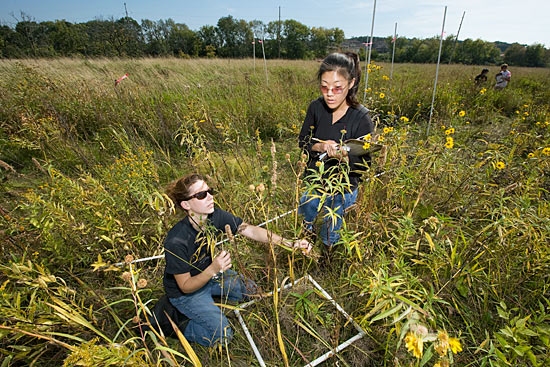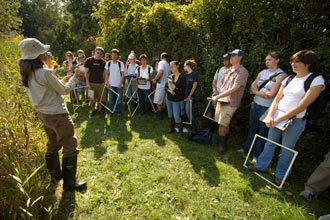Fight to save celebrated prairie continues

Alicia Rachow and Amy Hong take part in an ecological field experiment at the Greene Prairie site as part of Ecology 460. The students are studying ways to manage a highly invasive reed canary grass that has encroached on the natural prairie grasses of the Arboretum. To accurately measure the effectiveness of the project, the students catalog square sections of the prairie along the border area between the natural species and the invasive canary grass.
Photo: Bryce Richter
Standing in one of the world’s finest restored prairies on a recent afternoon, two dozen UW–Madison students gaze north into the past. In that direction, the Arboretum’s Greene Prairie offers a glimpse of Wisconsin’s historical landscape — a portrait awash in the yellows of late summer wildflowers, topped by gently swaying prairie grasses.
Slideshow
View a short slideshow of Greene Prairie.
What brings students here isn’t the idyllic scene, however, but the present-day threat they encounter upon turning around. Rising like a wall in front of them is a monotonous expanse of invasive reed canary grass. Aided by stormwater runoff from surrounding suburbs, it has consumed nearly 10 acres along Greene Prairie’s southern border and thwarted all efforts so far to contain it.
These students and more than 60 others from UW–Madison’s general ecology class have joined Arboretum researchers and land managers in an ambitious five-year plan to subdue the weed. Following recommendations from an Arboretum planning committee called the Adaptive Restoration Task Force, the team will test a combination of burning, herbicide treatments and seeding of native plants in a large-scale ecological restoration experiment.
By taking an experimental approach, scientists and land care staff are certain to gain new knowledge even if the strategy falls short of controlling the weed, says Arboretum ecologist Brad Herrick. A previous restoration experiment in Greene Prairie’s wettest section attests to this: Although it ultimately wasn’t effective against reed canary grass, it laid the foundation for the new attempt now under way.
“The earlier experiment didn’t give us the results we were looking for on the land, but we still got some questions answered,” says Herrick. “So then the task force set up another experiment to try new methods. Each time we do this, we learn more about what works and what doesn’t work, so that we eventually get closer to something that will work.”

Students participating in an ecological field experiment as part of an ecology class at the Greene Prairie site, located at the Arboretum, listen to instructions from Arboretum staff member Susan Kilmer. The students are studying ways to manage a highly invasive reed canary grass that has encroached on the natural prairie grasses of the Arboretum.
Photo: Bryce Richter
Finding an approach that will work against reed canary grass couldn’t be more urgent. The Wisconsin Department of Natural Resources estimates that the plant now dominates more than a half-million acres — or almost 10 percent — of the state’s wetlands, and has invaded many, many more. Once established, it spreads quickly via seeds and underground stems, snuffing out native plants at an alarming rate.
“It’s pretty stark when you’re standing in the middle of it,” says Susan Will-Wolf, laboratory instructor for the course. “You wouldn’t think that one plant could exclude everything else so completely.”
When native plants go, food and shelter for native wildlife go with them. But people also lose, says Herrick.
“We have to place some value on a prairie like this or else we lose where we came from,” he says. “We lose our heritage, our cultural identity. And I think that’s important to a lot of people.”
The strategy to save the renowned prairie is based on a decade’s worth of research by Joy Zedler, a botany professor and Arboretum research director. Experiment after experiment performed by Zedler’s students suggest that excess water, nutrients and sediments carried by urban storm water runoff are what give reed canary grass its edge, both in Greene Prairie and elsewhere.
With those inputs unlikely to stop anytime soon, in 2002 Zedler and graduate students Julia Wilcox and Mike Healy decided to try restoring Greene Prairie, even though they knew the odds were against them. The idea, says Healy, was to knock back the grass with a general herbicide, followed by seeding with 33 native species that would hopefully grow up and shade out the sun-loving invader.
“It worked pretty well for the first year,” Healy says, “and then the reed canary grass came back.” Within two years, in fact, treated areas of the prairie were barely distinguishable from those where the plant had been left unchecked.
Applying herbicide again seemed the obvious answer, except that the native species now struggling to survive would also be killed. So in the experiment’s third year — an unusually dry one — Healy tried a grass-specific herbicide called sethoxydim, with promising results.
Rainfall returned to normal levels the following year, however, filling the prairie’s southern fringe once more with standing water. Because regulations bar sethoxydim’s use in aquatic settings, the scientists could no longer apply it, and in no time at all the weed took over again, says Zedler.
“We’ve now given up on the wettest part of lower Greene Prairie and we’re moving to the edge of the reed canary grass infestation where it’s drier,” she says. “The invader should be more vulnerable at the edge of its distribution; at least, it’s a concept we need to test, and this experiment will help us do that.”
In the new plan, Arboretum staff will burn the experimental site and apply sethoxydim in the spring. Then, each fall, the ecology students will sow native seeds, survey plant diversity and abundance, and otherwise monitor the project’s progress. In keeping with its experimental nature, researchers will review the data carefully each year and make adjustments to the approach as needed.
The team hopes not only to keep reed canary grass from spreading further, but also to push it back eventually toward the south. No matter what the final outcome, however, Herrick has no doubts about the benefits.
“At a time when resources are stretched, we could never, as Arboretum staff, pull off this experiment on our own. So incorporating the students is a perfect way to do this,” he says. “It’s an education for them — first and foremost. But we also get to advance restoration ecology research and answer land care questions. It’s a win, win, win, all the way around.”
Tags: arboretum, ecology, environment, learning, slide show, student resources





